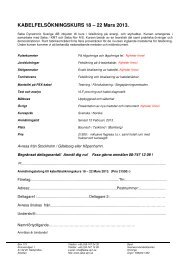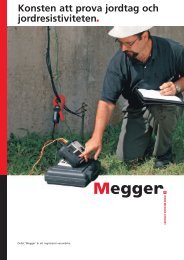A practical guide to earth resistance testing - Weschler Instruments
A practical guide to earth resistance testing - Weschler Instruments
A practical guide to earth resistance testing - Weschler Instruments
Create successful ePaper yourself
Turn your PDF publications into a flip-book with our unique Google optimized e-Paper software.
3. Large electrical networks contain noise consisting of the frequency of<br />
the power utility and its harmonics, plus high frequency noise from<br />
switching, etc., and induced signals from other sources; the ground<br />
tester must retrieve and analyze a small test signal in a much larger<br />
test environment; most ground testers only inject a single frequency<br />
(usually 128 Hz) which is adequate in most situations because it avoids<br />
harmonics of standard line frequencies; unfortunately, it is often not<br />
adequate in substations; this type of interference can cause significant<br />
measurement errors.<br />
Addressing the Testing Challenges in Large Ground Systems<br />
In the ideal world, <strong>testing</strong> a large ground system would be conducted in<br />
complete accordance with the Fall-of Potential Method. Unfortunately,<br />
the large “<strong>resistance</strong> areas” found in large ground systems may make<br />
it unfeasible or even impossible <strong>to</strong> carry out this test. As noted above,<br />
setting the current test probe 10 times the maximum distance of the<br />
ground system can require leads <strong>to</strong> be many thousands of feet. In these<br />
situations, the Slope Method can be used effectively because it does not<br />
require the user <strong>to</strong> find the “flat” portion of the curve or <strong>to</strong> know the<br />
electrical center as a point from which <strong>to</strong> measure. Readings are taken at<br />
20 percent, 40 percent and 60 percent of the current probe distance and<br />
fit in<strong>to</strong> a mathematical model of the <strong>resistance</strong> characteristic. Appendix III<br />
provides a detailed explanation of the Slope Method, including relevant<br />
tables.<br />
For the Slope Method <strong>to</strong> provide meaningful results, accurate<br />
measurement of the variations at different points is critical. Since large<br />
ground systems typically have <strong>resistance</strong> values of less than 0.5 Ω, the<br />
differences can be quite small. An instrument with 1 mΩ measurement<br />
resolution can indicate the small differences between low readings.<br />
Noise is a major problem in <strong>testing</strong> large ground systems, and must be<br />
addressed <strong>to</strong> ensure accurate results. To be effective, the test instrument<br />
must be designed <strong>to</strong> overcome the effects of significant noise in the test<br />
environment. Among the technical capabilities that can help offset the<br />
noise problem are:<br />
n A variable test frequency (rather than a single, fixed test frequency)<br />
which can help remove any stray noise that could affect the reading.<br />
n A high peak-<strong>to</strong>-peak interference suppression level.<br />
n A sophisticated filter system <strong>to</strong> reject more noise.<br />
n Various current settings <strong>to</strong> improve the signal-<strong>to</strong>-noise ratio when<br />
necessary.<br />
The other challenges faced in <strong>testing</strong> large ground systems relate <strong>to</strong> the<br />
capabilities of the test instrument. Improved technology has made it<br />
possible for instruments <strong>to</strong> be designed that address problems created<br />
by the characteristics and conditions found in and around large ground<br />
systems.<br />
44 1-866-254-0962 www.megger.com Getting Down <strong>to</strong> Earth 45




